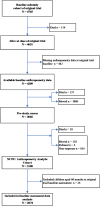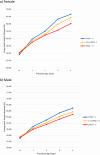Early childhood height is a determinant of young adult stature in rural Nepal
- PMID: 39080560
- PMCID: PMC11289932
- DOI: 10.1186/s12889-024-19469-8
Early childhood height is a determinant of young adult stature in rural Nepal
Abstract
Background: Does preschool height predict adult stature in undernourished settings? The extent to which preschool length or height forecasts young adult stature is unclear in chronically undernourished populations.
Methods: In 2006-8, we assessed height in a cohort of 2074 young adults, aged 16-23 years, in rural Nepal who, as preschoolers (≤ 4 year), were measured at baseline and again 16 months later during a vitamin A supplementation trial in 1989-91. We assessed by linear regression the ability of preschool length (L, measured < 24 mo) or height (Ht, 24-59 mo), at each year of age to predict 16-23 year old height, adjusted for month of young adult age, interval duration (in months), caste, preschool weight-for-height z-score and, in young women, time since menarche, marriage status and pregnancy history.
Results: Young women were a mean of 0.81, 1.11, 0.82, 0.24, 0.44 cm taller (all p < 0.01) and young men, 0.84, 1.18, 0.74, 0.64 and 0.48 cm taller (all p < 0.001) per cm of attained L/Ht at each successive preschool year of age and, overall, were 2.04 and 2.40 cm taller for each unit increase in preschool L/Ht z-score (L/HAZ) (both p < 0.001). Coefficients were generally larger for 16-month follow-up measurements. The percent of young adult height attained by children with normal L/HAZ (>-1) increased from 38-40% mid-infancy to ∼ 69-74% by 6 years of age. By 3-6 years of age heights of stunted children (L/HAZ<-2) were consistently ∼ 4-7% lower in their young adult height versus normal statured children. There was no effect of preschool vitamin A receipt.
Conclusions: Shorter young children become shorter adults but predictive effects can vary by sex, age assessed, and may be influenced by year or season of measurement.
Keywords: Adult height; Child height; Linear growth; Nepal.
© 2024. The Author(s).
Conflict of interest statement
The authors declare no competing interests.
Figures


References
-
- Tanner JM. A history of the study of human growth. Cambridge University Press; 1981.
-
- Bogin B. Patterns of human growth. 3rd ed. Cambridge: Cambridge University Press; 2020. 10.1017/9781108379977.
Publication types
MeSH terms
Substances
LinkOut - more resources
Full Text Sources
Medical

